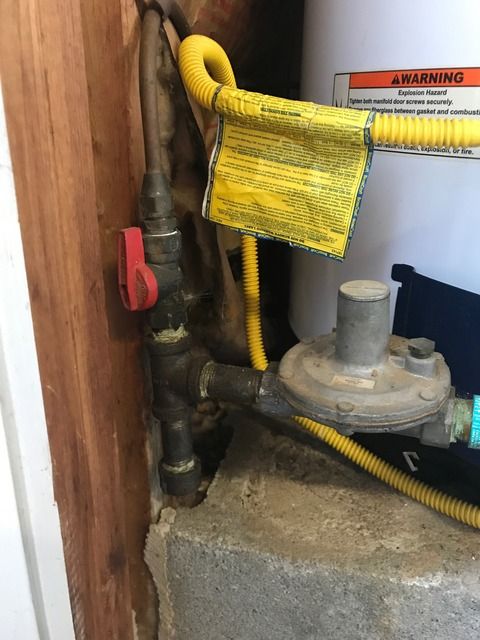 
Over 698,000 strictly plumbing related posts
Plumbing education, information, advice, help and suggestions are provided by some of the most experienced plumbers who wish to "give back" to society. Since 1996 we have been the best online (strictly) PLUMBING advice site. If you have questions about plumbing, toilets, sinks, faucets, drains, sewers, water filters, venting, water heating, showers, pumps, and other strictly PLUMBING related issues then you've come to the right place. Please refrain from asking or discussing legal questions, or pricing, or where to purchase products, or any business issues, or for contractor referrals, or any other questions or issues not specifically related to plumbing. Keep all posts positive and absolutely no advertising. Our site is completely free, without ads or pop-ups and we don't tract you. We absolutely do not sell your personal information. We are made possible by: 
|
|
Author:
jcrevz (NC)
Switching from electric to gas range. Gas water heater directly on the other side of wall in garage, 1/2" copper tubing supply that runs through the crawlspace from the meter on the other side of the house underneath the kitchen. Copper is flared to black pipe for regulator and valve for water heater. Old gas log fireplace on meter side of house tee'd off same line close to the meter, but capped now (wood burning). Not sure of Btu's for the water heater or the range but I could get that later if needed. Can I sweat in a tee on this same tubing, to feed the range? Would this be done under the crawl and stubbed through the floor or in the garage and stubbed through the wall? Extend/tee off the black pipe? What is the typical install for this?
Edited 2 times.
|
|
Post Reply
|
|
|
Author:
packy (MA)
since you are talking about copper tubing, i'm guessing that you have propane ???
anyway, connect to black pipe in the garage and run 1/2 inch copper to the stove.
the joints are all flared not soldered.
post a picture of the water heater gas piping so we can give more accurate advice,
you will need an inexpensive flaring tool like this..
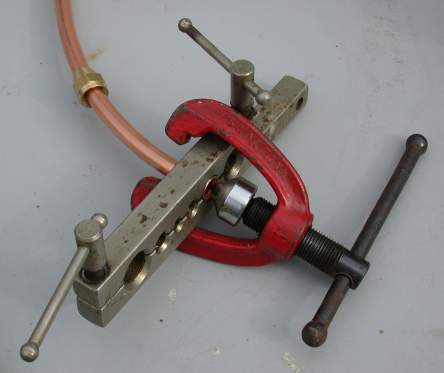
|
|
Post Reply
|
|
|
Author:
jcrevz (NC)
Its natural gas. I have a flare tool I was just more worried about enough BTUs and the how it is typically done. Give me a few to post the pic of the water heater supply.
|
|
Post Reply
|
|
|
Author:
packy (MA)
better check on the legality of copper used for natural gas. they just revised my MA code to allow it with press fittings. NC is different.
in any case 1/2 inch OD copper will not give you enough BTU's to do what you want.
you might be best to go back near the meter and run 1/2 inch CSST to the water heater and then break for each.
looks like this...

connects like this..
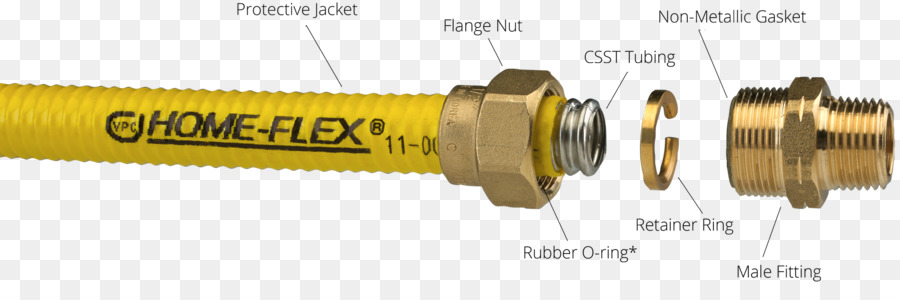
Edited 1 times.
|
|
Post Reply
|
|
|
Author:
packy (MA)
The National Fuel Gas Code (NFPA 54/ANSI Z223.1) and all of the major model building codes have approved copper for the use in fuel gas systems. In fact, in states like Minnesota, Alabama, Georgia, Florida, etc, copper is the dominant, if not the primary choice, for flexible fuel gas piping systems in homes and multi-family units. IAPMO approved copper for use with fuel gas in 1999.
In certain areas of the country it has been against the code to install copper tube for natural gas distribution. This was primarily in areas of the country that utilized the Uniform Plumbing Code, predominately in the West, and most actively in California.
However, at that same time many other areas of the country were successfully installing copper tube in both natural gas and LP gas distribution systems. Many of these areas have been installing copper tube for natural gas distribution for better than 35 - 40 years (Minnesota, St. Louis, Atlanta, Washington D.C. among others) and for most of the country copper tube has been the standard material for LP gas distribution much longer than that.
In the beginning, the reason for this disparity throughout the country in the acceptance of copper tube for this use had to do with the gas being supplied. In the southwest area of the country sour gas (gas containing a significant amount of hydrogen sulfide) was not uncommon, and the use of copper tube in a gas stream containing significant amounts of hydrogen sulfide and moisture lead to the black flakes to which you refer. It should be noted that this was generally encountered in natural gas systems, not LP gas systems (LP being a manufactured gas was more closely controlled with regards to contaminants). However, in the rest of the country the natural gas being supplied did not contain such high concentrations of hydrogen sulfide, allowing for the successful use of copper tube. This was reflected in the codes and standards used throughout the rest of the country allowing copper tube for this use (such as the NFPA 54 National Fuel Gas Code, the BOCA National Mechanical Code and the SBCCI Standard Mechanical Code).
In the last 35 - 40 years, the cleaning and distribution of natural gas throughout the country has improved greatly, especially with the development of regulations strictly limiting the amount of hydrogen sulfide and other contaminants that could be distributed in the gas stream, especially for those gases being supplied over nationwide, inter-linked gas distribution pipelines/systems. These regulations limit the hydrogen sulfide to such a level that it should no longer be available in large enough quantities to promote the black flaking that you had seen in the past.
Recognizing this fact, and the fact that the use of copper tube for the natural gas distribution system allowed gas utilities and building owners to provide natural gas as a cost effective alternate energy source to electric, has led many areas of the country that previously banned the use of copper in this use to reevaluate their position. Most notably, the Pacific northwest (Oregon and Washington especially) have recently begun to aggressively promote and use copper tube for their natural gas distribution systems, regardless of the restriction in the Uniform Plumbing Code.
Following suit, IAPMO, through the use of the consensus process voted to change the Uniform Plumbing Code to lift the restriction on the use of copper tube for fuel gas distribution systems. These changes were published in the 2000 edition of the UPC and UMC.
However, since all natural gas supplies are not necessarily delivered via pipelines regulated by the above regulations, all of the codes allowing for the use of copper in natural gas distribution systems do contain the restriction that bare copper tube not be used if the gas stream contains an average of more than 0.3 grains of hydrogen sulfide per 100 standard cubic feet of gas. Should the gas stream exceed this amount, the codes permit the use of copper tubing if the tube is tin-lined. These requirements are in place to minimize the possibility of flaking inside the copper and to ensure an efficient and successful use of copper tube for this application.
|
|
Post Reply
|
|
|
Author:
packy (MA)
not knowing what your local code does or does not allow, i'm gonna back off and not give any advice.
sorry but i would rather say nothing than give you advice when i'm not familiar with your codes..
|
|
Post Reply
|
|
|
Author:
jcrevz (NC)
AHH now you get to the meat of the question - this is how my home built in 2007/8 was piped (CSST), the new home is copper and was built in 94. Thus the question of if I could just tap into the 1/2 copper tubing. REALLY dont feel like going back to the meter and redoing everything but if I have to well then, I guess I have to
Edited 1 times.
|
|
Post Reply
|
|
|
Author:
jcrevz (NC)
Just went through the code book, and semi-rigid copper tubing is accepted so thats good news. The only thing I have to figure out now is if it can deliver the proper amount of gas to both appliances.
|
|
Post Reply
|
|
|
Author:
hj (AZ)
Because of the danger if the fire "melted" the solder joints, when copper is used the joints SHOULD be flared or brazed. Your connection is neither, and tubing size looks like it is smaller than 1/2", (maybe 1/2" o.d.), and if so it is insufficient for the heater by itself
Edited 1 times.
|
|
Post Reply
|
|
|
Author:
steve_g (CA)
The reg makes me wonder if it isn't 2 pound NG.
|
|
Post Reply
|
|
|
Author:
steve (CA)
If you have a 2 psi natural gas system, ½" OD is big enough for the stove and water heater. If less than 2 psi, not big enough for the stove and you would need to start a new pipe run from the meter.
|
|
Post Reply
|
|
|
Author:
Paul48 (CT)
The regulator tells a story.
|
|
Post Reply
|
|
|
Author:
jcrevz (NC)
Some more info now that I was able to get home and poke around (I was at work getting relayed info from my wife)
1/2” OD copper tube - +/- 40’ run from the meter
40,000 btu water heater
Called the gas company, she said I have a basic meter so its .5 psi
I have a magnahelic to measure WC but havent got around to it.
I cant find total BTU on the range specs but for the burners I have 5 at
Burner #1 Max BTU 12000
Burner #2 Max BTU 5000
Burner #3 Max BTU 15000
Burner #4 Max BTU 18000
Burner #5 Max BTU 10000
Also, not sure about the furnace, its in the attic but I only have one 1/2" copper from the meter into the crawlspace so I would assume its tee'd off and going up the wall to the furnace.
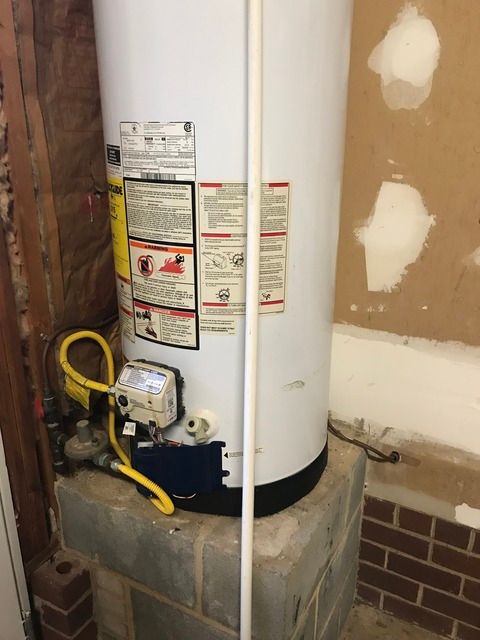
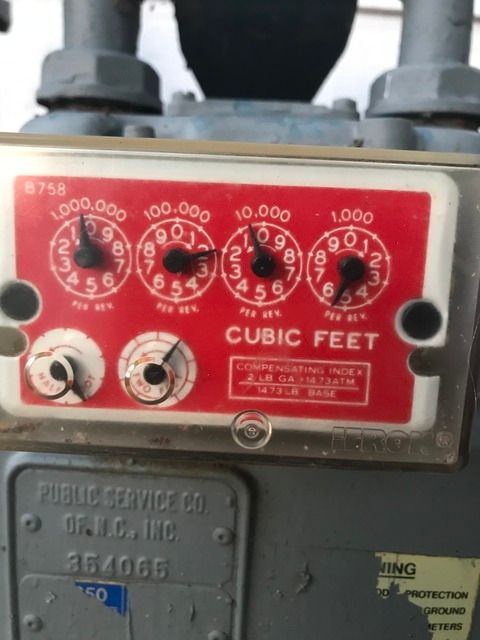
Edited 4 times.
|
|
Post Reply
|
|
|
Author:
packy (MA)
you didn't mention that you have a gas furnace as well...
don't bother checking your pressure. the gas co. is wrong. you have 2 PSI or else nothing would work..
as someone else said, the pressure regulator at the water heater tells us this..
anyway, you are pushing the limit with 1/2 inch OD feeding a furnace and a water heater. (even with 2 PSI)
adding a stove will exceed your given capacity.
you may be able to run CSST into the crawl space and put 2 full size tees to branch to the furnace, the water heater and the stove.
should be pretty simple. couple of full size tees with flare x male adapters in them.
connect the line to the furnace and the line to the water heater right back to their own separate adapters with the 3rd adapter used for the stove.
CSST is rated for 5 PSI so need to worry.
remember, you will need to deal with the 2 PSI going to the stove.
|
|
Post Reply
|
|
|
Author:
hj (AZ)
Without some specifications it is hard to tell whether that is an appliance or pounds to inches regulator. IF it is a 2psi system there will usually be some marking or tag at the meter.
Edited 1 times.
|
|
Post Reply
|
|
|
Author:
packy (MA)
hj, if his system is .5 PSI as someone told him, there is no way he can run a furnace in the attic and a water heater in the garage with 1/2 inch OD tubing.
|
|
Post Reply
|
|
|
Author:
bernabeu (SC)
pic of meter says:
compensating index
2 lb gas
==============================================
"Measure Twice & Cut Once" - Retired U.A. Local 1 & 638
|
|
Post Reply
|
|
|
Author:
jcrevz (NC)
found a sticker on the line i didnt see before because of placement that reads 2 PSI gas pressure.
So whats the best course of action then? csst to a manifold?
Edited 2 times.
|
|
Post Reply
|
|
|
Author:
packy (MA)
i would run piping as i described above.
CSST run to a couple of tees in the crawl space.
|
|
Post Reply
|
|
|
Author:
jcrevz (NC)
OK so heres the gameplan -
3/4" black iron pipe stubbed into the crawlspace from the meter, then 1/2" csst run to the water heater tee'd at the range and furnace. Its ok to use the proper adapters to connect the copper to the csst for the furnace in the attic right? I figured I would just go all the way to the water heater since its only another 3' past the range. Im going to have to bond the csst and drive a ground rod at the meter because the closest electrical panel isnt close.
Edited 3 times.
|
|
Post Reply
|
|
|
Author:
jcrevz (NC)
One last question before I go ahead - so it is OK to leave the copper in the wall going up to the furnace in the attic, cut/flare it and connect to the csst? Im going 1/2" csst to every other appliance including the water heater. getting rid of all the copper.
|
|
Post Reply
|
|
|
Author:
packy (MA)
you can not conceal copper gas pipe because it could get hit with a nail or a screw..
you can conceal CSST but you can not fasten it. it must remain totally movable.
csst must be protected where it passes thru the 2 x 4 on the bottom and top of the wall.
look online for regulations regarding CSST..
as to your question..
yes you can connect flared copper to CSST
|
|
Post Reply
|
|
|
Author:
jcrevz (NC)
Went through the new code book for NC so I’m good there - cant find if I need a drip leg off the meter but I dont think so - Packy, what do you support csst with in the crawlspace? Jhooks? Wrapped Zip ties screwed to the joist? thats how the existing copper is supported
Edited 1 times.
|
|
Post Reply
|
|
|
Author:
packy (MA)
tube talons..
they are cheap so use a lot of them
talons for 3/4 copper will fit 1/2 inch CSST nicely.

|
|
Post Reply
|
Please note:
- Inappropriate messages or blatant advertising will be deleted. We cannot be held responsible for bad or inadequate advice.
- Plbg.com has no control over external content that may be linked to from messages posted here. Please follow external links with caution.
- Plbg.com is strictly for the exchange of plumbing related advice and NOT to ask about pricing/costs, nor where to find a product (try Google), nor how to operate or promote a business, nor for ethics (law) and the like questions.
- Plbg.com is also not a place to ask radiant heating (try HeatingHelp.com), electrical or even general construction type questions. We are exclusively for plumbing questions.
Search for plumbing parts on our sponsor's site:
Special thanks to our sponsor:

|







